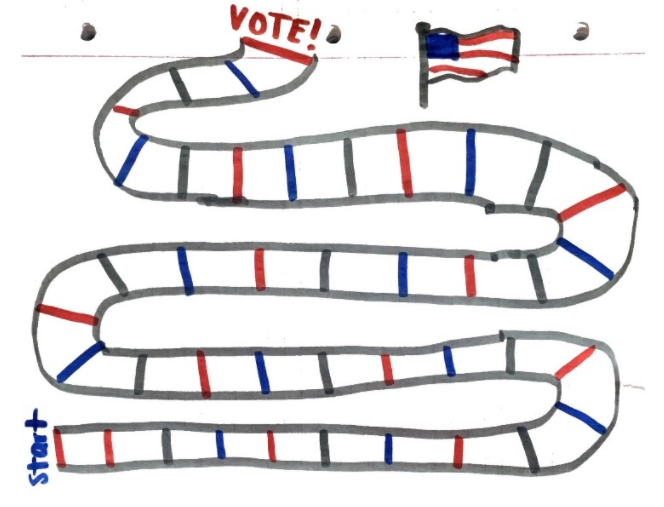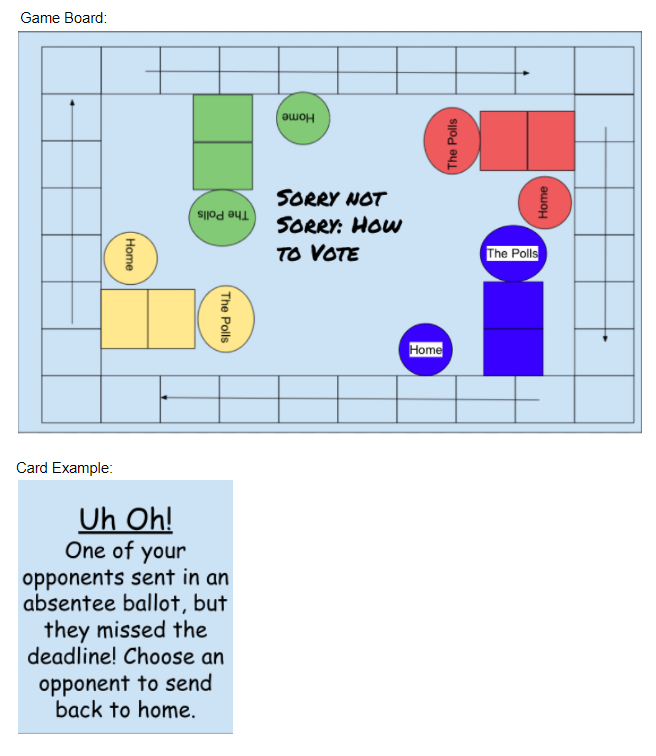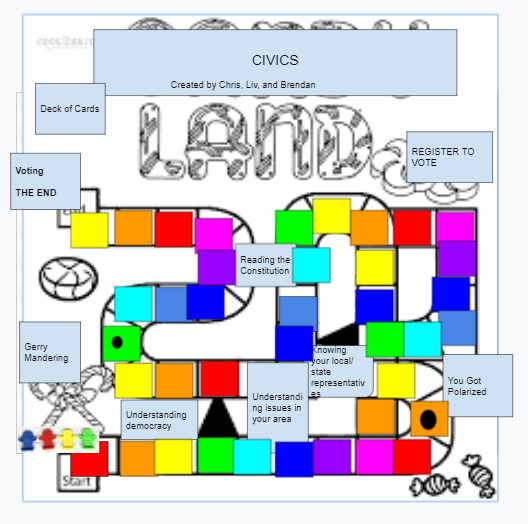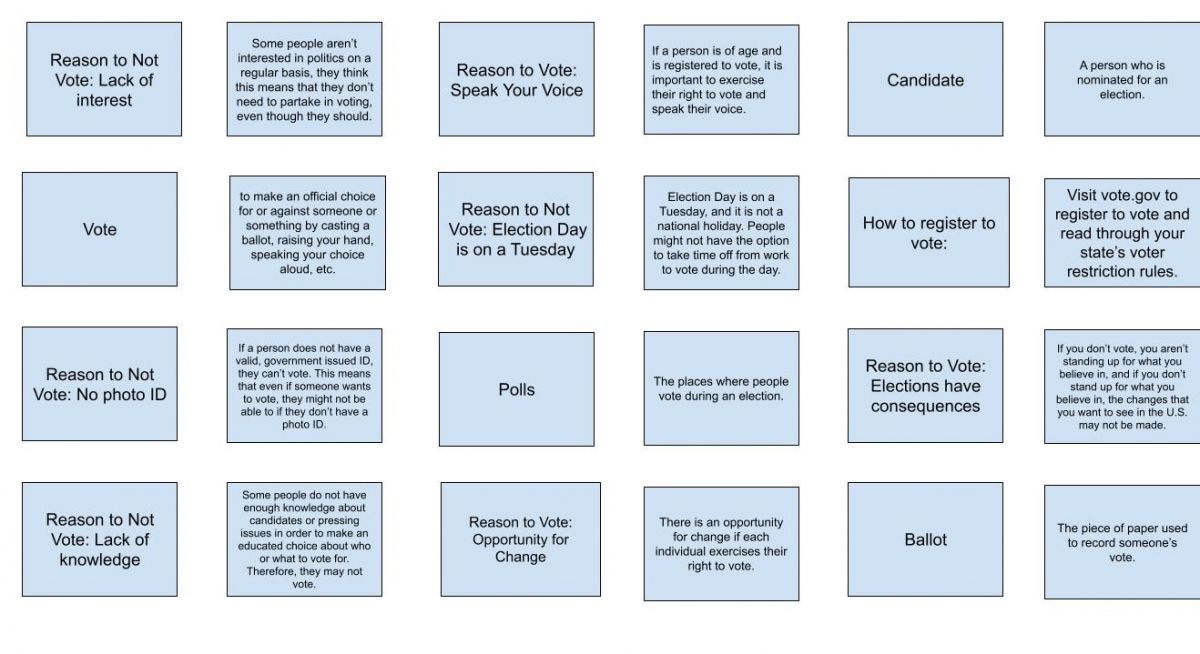Youngsters from elementary school to high school and college play digital games for entertainment on gaming devices, computers, and smartphones. NIM, the first mathematical game on a computer, was introduced at the World's Fair of 1939-1940. NIMROD, the next version of that game, was created in 1951. In 1962, Spacewar! became the first game playable on multiple stations. Space Invaders arrived in 1980 in advance of a huge expansion of gaming on the then newly created Internet. XBox was released in 2002; Nintendo Wii in 2006; Angry Birds in 2009; and Pokemon Go in 2016 (see The History of Online Gaming, Medium, January 20, 2017).
Online gaming is now everywhere, with mixed and virtual reality experiences emerging as the newest innovation in the gaming industry. But can gameplay influence young people to become voters and actively-engaged democratic citizens?

Figure \(\PageIndex{1}\): VotingLand by Elizabeth Mooney & Leanna Van
Many educators and game designers believe so and are developing serious games to promote civic awareness and participation.
iCivics, founded in 2008 by former Supreme Court Justice Sandra Day O’Connor, offers a wide-ranging collection of online games about all aspects of American government and law.
In the run-up to the 2020 Presidential election, the organization Rock the Vote created the game Build the Vote in Minecraft.
The United Nations Office for Disaster Risk Reduction published Stop Disasters! - games that challenge players to take governmental and environmental actions to prevent floods, earthquakes, and other natural calamities.
Spent is an online game about surviving poverty and homelessness.
Video \(\PageIndex{1}\): Video accompanying activities for Building Democracy for All, Topic 4, Standard 5. Uploaded by Umass Democracy for All. YouTube source:
In these activities, you will evaluate a currently available, politically themed online digital game, then design your own game about voting and politics.
Activity 1: Evaluate a Politically Themed Digital Game
- Choose a politically themed digital game from iCivics, Minecraft, Stop Disasters!, or another source and play it enough so you understand its purpose and structure.
- Critically analyze the purpose, design, and structure of the game, using the following prompts as a guide:
- What do you think young people will learn from the game?
- Whose stories are told in the game? Whose stories are left out?
- How credible and trustworthy is the information in the game?
- What type of language and visuals are used in the game? How might the language and/or visuals influence the players of the game? Why do you think the game designers chose the specific language/visuals?
- Why is the game designed the way it is? How do you know this?
- Do you believe this game can influence young people to vote or to become more engaged as citizens in their communities?
- Then, complete the following activities:
- Create a screen recording video in which you present your findings.
- Identify at least 3 ways to improve the game to increase voting and civic participation by young people and share these ideas with the game designer (e.g., write a letter, Tweet to the game company).
Activity 2: Design Your Own Game
- Imagine you have been asked to design a game for elementary, middle, or high school students that would influence their thinking about voting and/or civic engagement.
- First, explore gamification principles:
- Consider the following prompts:
- How would that game function?
- How would you balance competition for points with social problems to solve?
- Then, design a pencil and paper or digital prototype of the game. Check out the following examples for inspiration:

Figure \(\PageIndex{2}\): Sorry not Sorry: How to Vote by Caroline Gabriel, Ruihan Luo, & Sara Shea

Figure \(\PageIndex{3}\): CivicsLand by Liv Sanfacon, Brendan Sarles, & Christopher Spinozzi

Figure \(\PageIndex{4}\): Memory Matching Game: Voting 101 by by Sophia Hajjar and Kayleigh Francis
Additional Resources
Connecting to the Standards
- Massachusetts Civics & Government Standards
-
- Describe how a democracy provides opportunities for citizens to participate in the political process through elections, political parties and interest groups. (Massachusetts Curriculum Framework for History and Social Studies) [8.T4.5]
- ISTE Standards
- Digital Citizen
- 2c: Students demonstrate an understanding of and respect for the rights and obligations of using and sharing intellectual property.
- Knowledge Constructor
- 3a: Students plan and employ effective research strategies to locate information and other resources for their intellectual or creative pursuits.
- 3b: Students evaluate the accuracy, perspective, credibility and relevance of information, media, data or other resources.
- 3d: Students build knowledge by actively exploring real-world issues and problems, developing ideas and theories and pursuing answers and solutions.
- Innovative Designer
- 4a: Students know and use a deliberate design process for generating ideas, testing theories, creating innovative artifacts or solving authentic problems.
- 4b: Students select and use digital tools to plan and manage a design process that considers design constraints and calculated risks.
- 4c: Students develop, test and refine prototypes as part of a cyclical design process.
- 4d: Students exhibit a tolerance for ambiguity, perseverance and the capacity to work with open-ended problems.
- Creative Communicator
- 6a: Students choose the appropriate platforms and tools for meeting the desired objectives of their creation or communication.
- 6b: Students create original works or responsibly repurpose or remix digital resources into new creations.
- 6c: Students communicate complex ideas clearly and effectively by creating or using a variety of digital objects such as visualizations, models or simulations.
- 6d: Students publish or present content that customizes the message and medium for the intended audiences.
- DLCS Standards
- Ethics and Laws (CAS.b)
- Interpersonal and Societal Impact (CAS.c)
- Digital Tools (DTC.a)
- Collaboration and Communication (DTC.b)
- Research (DTC.c)
- English Language Arts > History/Social Studies Common Core Standards
- CCSS.ELA-LITERACY.RH.6-8.5
- CCSS.ELA-LITERACY.RH.6-8.6
- CCSS.ELA-LITERACY.RH.6-8.7
- CCSS.ELA-LITERACY.RH.6-8.8
- CCSS.ELA-LITERACY.RH.9-10.5
- CCSS.ELA-LITERACY.RH.11-12.5
- CCSS.ELA-LITERACY.RH.11-12.7





